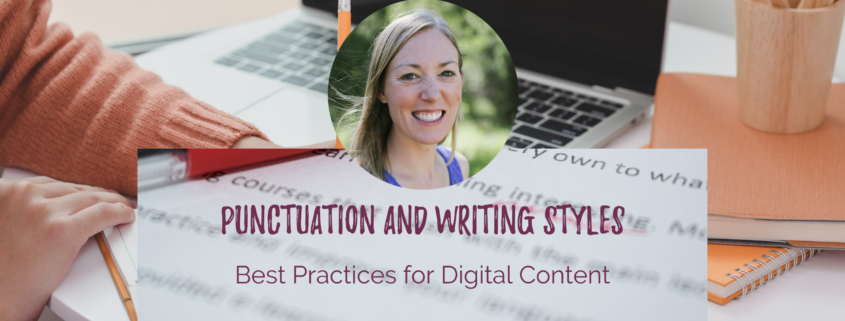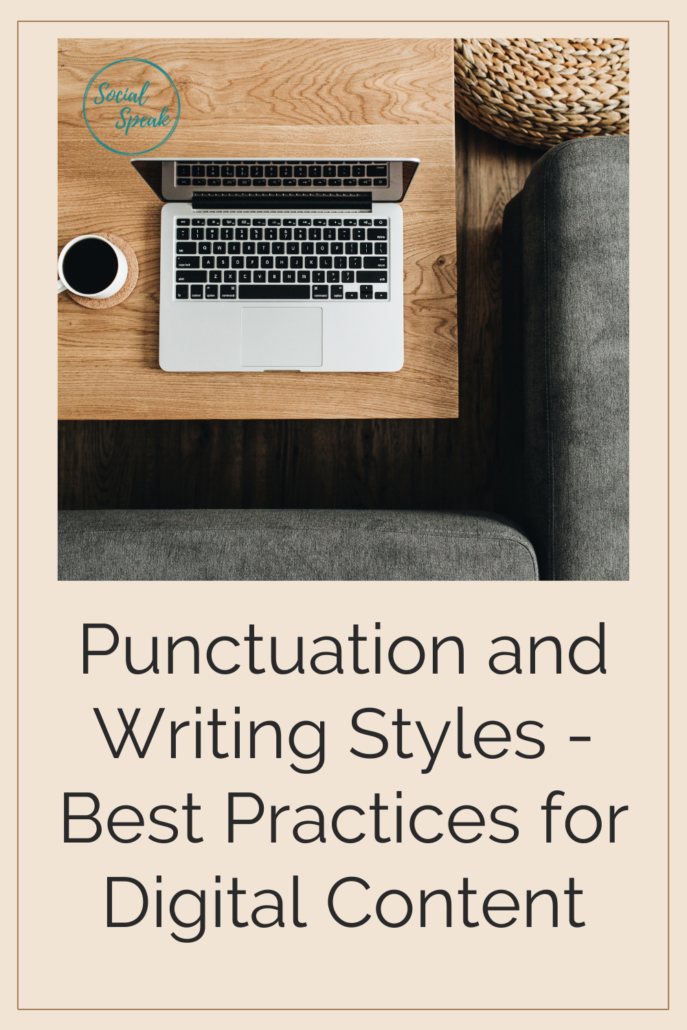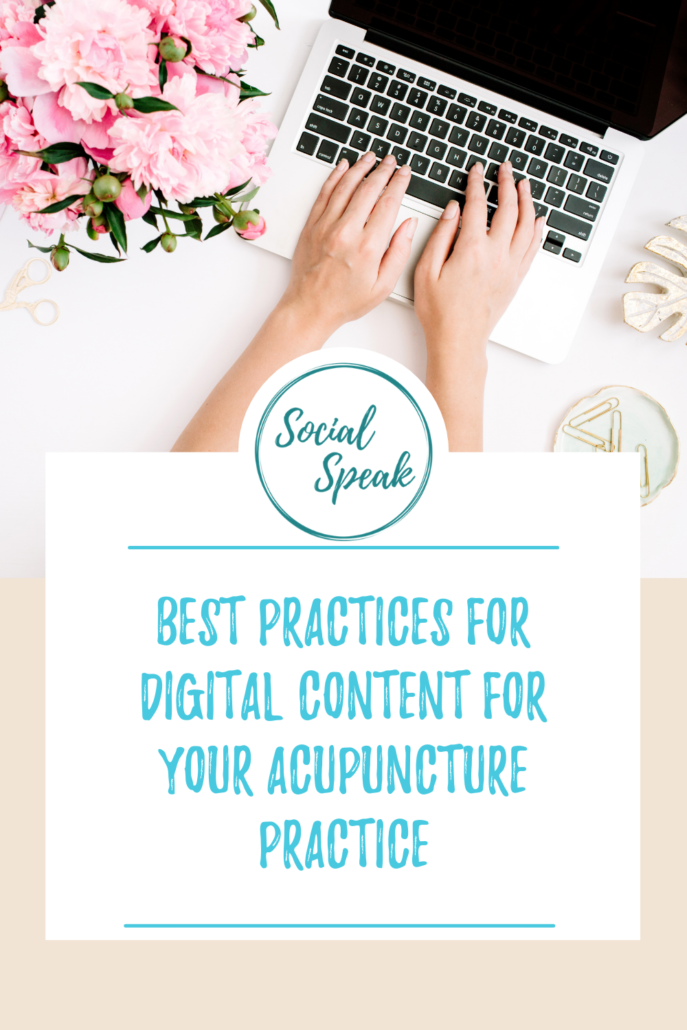In this blog post we are going to be diving into some tips and recommendations that we follow for punctuation, mechanics, and general style guides for your digital content creation.
We’ve found over the years that there are a lot of different preferences for writing styles online, and though you want your voice to reflect your brand and speak to your target market, there are some things that we consistently see businesses doing online that they potentially shouldn’t be doing.
We are focusing on websites, blogs, and social media, rather than white papers, research articles, and other technical guides. However, many of the points discussed can be brought into this type of writing, as well.
Also, it is important to note that digital content does differ drastically from print, scholarly articles, and research. Additionally, this isn’t a complete guide, but top tips to step your writing up a notch.
Punctuation in Digital Content
Periods (.) – These mark the end of a sentence, but the reason I bring them up is the age-old question of one space or two after a period. For years the APA style guide was the only guide to recommend two spaces after a period to help with readability. However, in 2019, the guide was changed to one space. Long before this, our team recommended one space after a period in digital content for the pure reason that if you have two spaces and the screen-size changes, you may find that a space begins the following line of content. This will not occur with one space.
Periods or Commas and Quotation Marks – A common question we are asked is where should a period or comma go when quotes are involved. This is a little trickier because American and British writing rules and use of double (“ “) vs single (‘ ‘) quotation marks differ. We are in the US, so follow the American Quotation Marks rules. In general periods and commas go before closing quotation marks.
Single Quotation Marks – in the US, single quotation marks are used to quote someone within a quote of someone else.
Question Marks or Exclamation Points and Quotation Marks – If a question or exclamation applies to the quotation itself, place the question mark or exclamation point inside the quotation mark. If it applies to the whole sentence, place the punctuation marks outside.
Examples:
Can you believe the ending to “Inception”?
Vs
Last night I watched “Inception.”
Vs
I shouted to my dog, “Come here and get a treat!”
Semicolons (;) – in general, don’t use these unless you are 100% certain you know what you are doing. Semicolons join two independent clauses without a conjunction (eg and). They are more meaningful than commas but less so than a period. In general:
- if you find yourself using semicolons, switch to periods instead
- If you want to use a conjunction like and or but use a comma
- If you are writing a list and the items within the list include commas or sentences, a semicolon is used to divide the items listed. In digital writing, bullet points tend to be easier to read.
Commas – commas indicate small breaks or soft pauses in sentences. They separate words, clauses, or ideas. Places to use commas include:
- In a list of three or more phrases or words please be consistent with your use of the Oxford comma or Serial comma – the comma before the and of the last item in a list. Including it or not is fine, just be consistent.
- If your sentence has an introductory phrase, such as “before running ads,” use a comma.
- There are lots of times to use commas and a lot of times where commas should not be used. Again, Grammarly outlines these cases in a lot more detail!
Writing Mechanics for Digital Content
Abbreviations – Typically blogs and digital content tends to be more informal, so we are okay using abbreviations as long as the reader is familiar with what the abbreviation refers to. For acronyms, we do recommend writing the full name the first time it appears on a web page or blog post and including the abbreviation in parenthesis. If the acronym is not often used by your target market, however, it may be more advantageous to use the complete name consistently for SEO.
Spelling – The big thing here is to make sure you are using American English vs British English consistently and that you run your content through a spell-checker. Grammarly has a free chrome extension that works with your WordPress blog and email. This can help if you swap a homophone, for example.
Capitalizations – One of the most common grammar-discussions we have is when a specific word, not at the start of a sentence should be capitalized. Many clients have an urge to capitalize words to draw attention to them, but bolding or underlining the word would actually be more appropriate. Below are a few considerations:
- Headers – keep consistent with headers. Are you going to capitalize every letter, every word, or nouns, verbs, adjectives, and proper nouns (conjunctions and prepositions such as of and the are uncapitalized)?
- Names of Services or of Your Business – if it is a name of a service or process that you follow, this can and should be capitalized.
Style for Digital Content
Parallelism – Another one of my biggest pet-peeves is parallelism. Any time you have a list, please make sure each phrase has the same grammatical structure. If a list of two or more phrases uses a noun, make sure all are nouns. If there is a gerund (word ending in -ing), make sure all of them are gerunds. Grammarly has some great examples that show how you can adjust sentences so there is parallelism, here.
Tense – Big things to think about here are if you are speaking in a passive voice, first-person, active voice, etc. In digital content, specifically marketing collateral, an active, first-person voice can be the most impactful. Write from your first-hand experience using “I” rather than “He/She/They.” For active vs passive, consider the following examples:
- Active: I wrote the book.
- Passive: The book was written by me.
Both are correct, the active tense just has more of a punch!
General Sentence Structure – I asked a couple of my favorite copywriters for advice and pointers to put in this blog and both had additional comments on sentence structure.
Amy Colo, a copywriter who focuses on keyword research and SEO, made sure to mention how important it is to find a balance between a conversational tone and making sure each sentence includes only one thought or idea. Rather than using conjunctions or trying to fit everything into one sentence, which often creates run-on sentences like this one, it is advantageous for readability and comprehension to only convey a single thought or idea in each sentence.
Additionally, to increase readability even more, keep paragraphs short.
Having a paragraph that is only a sentence or two can be much more impactful than a longer paragraph that we are taught to write in school.
(How many of you read the two lines above this more closely than the run-on sentence before?)
Heather Bowen-Ray, another one of our go-to copywriters in health and wellness, made sure to emphasize two points:
- Altering your sentence structure and sentence length can make your content more interesting to read.
- Breaking grammar rules is okay! Rules are meant to be broken and if breaking a rule when it comes to grammar makes your headline or a service description more impactful – do it!
Heather focuses heavily with clients on creating style guides. If you don’t know where to start with copywriting and marketing, definitely reach out to her for help in creating a style guide.
I hope this post has been helpful and informative. If you find that you need help with your content writing for blogs, websites, newsletters, or social media, we would love to chat! Please reach out to us for a free 30 minute marketing consultation.
Also published on Medium.








